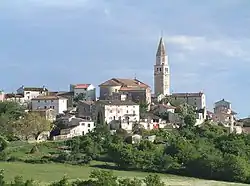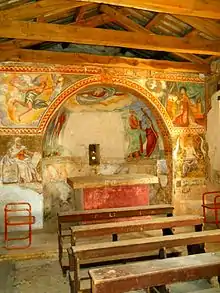Višnjan
Višnjan (Italian: Visignano) is a village and municipality in Istria, Croatia. Višnjan is the site of Višnjan Observatory (an astronomical observatory). The observatory is home of several long-running international summer programs for youth in astronomy, archeology, marine biology and other disciplines.
Višnjan
Visignano | |
|---|---|
Municipality | |
| Višnjan Municipality Općina Višnjan - Comune di Visignano[1] | |
 | |
Location of Višnjan in Istria | |
 Višnjan | |
| Coordinates: 45°16′39″N 13°43′34″E | |
| Country | |
| County | |
| Municipality | |
| Government | |
| • Mayor | Angelo Mattich[2] |
| Area | |
| • Municipality | 24.5 sq mi (63.5 km2) |
| • Urban | 0.5 sq mi (1.3 km2) |
| Population (2021)[4] | |
| • Municipality | 2,096 |
| • Density | 85/sq mi (33/km2) |
| • Urban | 664 |
| • Urban density | 1,300/sq mi (510/km2) |
| Time zone | UTC+1 (CET) |
| • Summer (DST) | UTC+2 (CEST) |
| Postal code | 52463 Višnjan |
| Area code | 052 |
| Website | visnjan |
Geography
Višnjan is located 12 kilometers east of Poreč and 3 kilometers west of Pula-Koper road. Višnjan is located on elevation of 244m and average municipality elevation is between 200-300m. One of the most notable sinkholes in Istria, Baredina, is located in the municipality.
Demographics
According to the 2021 census, its population was 2,096 with 664 living in the town proper.[4]
According to the 2001 census Višnjan had a population of 625 with a total municipal population of 2,187 of which 71.7% were Croats, 9.1% were Italians and 6.2% declared themselves as Istrians. Like most settlements in Istrian interior Višnjan is experiencing depopulation in the last decades as people are migrating towards the coast.
According to the 1921 census the majority of the population was italian.[5]
History
In the village of Strpačići, 1 km from Višnjan copper earrings and needles were found. Illyrians came to the region somewhere between 2000 and 1000 BC and were later replaced by Celts. The remains of the Celtic era can be found on the nearby Montemez hill which is Celtic for nice hill. Remnants of pottery can be found all over the area as well in the town itself. A few kilometers west from Višnjan there is a prehistoric and medieval settlement called Dilian with a monastery and church named Saint Mihovil dating from the 11th century. Višnjan was first mentioned in a document from 1003 AD. Višnjan was surrounded by a defense wall until the 18th century. The City was entered through a gate crowned with a Venetian lion and an open book. Višnjan was part of the Motovun municipality until 1847 when it became an independent municipality. It was subsequently incorporated into Poreč municipality in 1947. In 1976 an astronomical observatory was built in Višnjan and the town became the astronomy centre of Yugoslavia. In 1993 Višnjan again became an independent municipality.
Višnjan is partially surrounded by walls built in the 13th and 14th centuries, and in the town there is a Gothic church of St. Anton from the 15th century and the church of St. Quirik and Julita from the 19th century. [6]
Economy
Most of Višnjan's economy comes from agriculture mostly olive growing and viticulture. Višnjan is also known as one of the last resorts in Istria of autochthon Istrian bovine Boškarin. Boškarin, the first geno-park in Croatia, was founded With the intention of preserving Boškarin in Višnjan . Most of the people work on the coast and travel daily to work.
Towns and villages in municipality
|

References
- See the list of towns and municipalities Archived 2014-03-11 at the Wayback Machine in the Istria County (ref. to ) and the narodne-novine list (ref. to )
- Općina Višnjan,
- Register of spatial units of the State Geodetic Administration of the Republic of Croatia. Wikidata Q119585703.
- "Population by Age and Sex, by Settlements, 2021 Census". Census of Population, Households and Dwellings in 2021. Zagreb: Croatian Bureau of Statistics. 2022.
- La fonte di tutti i dati statistici è G.Perselli, I censimenti della popolazione dell‘Istria, con Fiume e Trieste, e di alcune città della Dalmazia tra il 1850 e il 1936, Unione Italiana Fiume-Università Popolare di Trieste, Trieste-Rovigno 1993
- "ISTRA.HR". www.istra.hr (in Croatian). Retrieved 2023-04-29.
